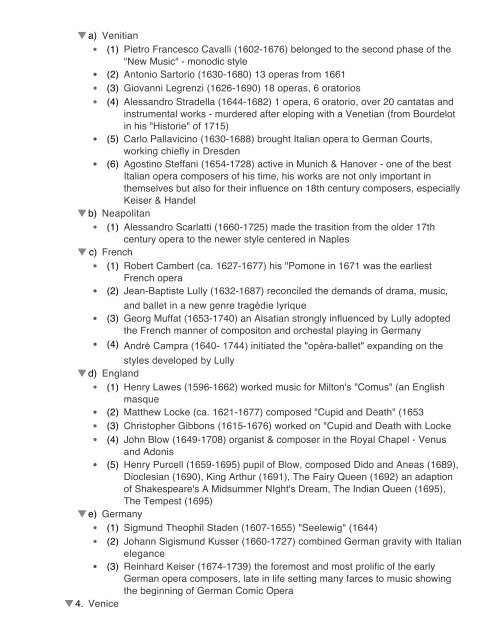An Outline of The History of Western Music Grout ... - The Reel Score
An Outline of The History of Western Music Grout ... - The Reel Score
An Outline of The History of Western Music Grout ... - The Reel Score
Create successful ePaper yourself
Turn your PDF publications into a flip-book with our unique Google optimized e-Paper software.
a) Venitian<br />
(1) Pietro Francesco Cavalli (1602-1676) belonged to the second phase <strong>of</strong> the<br />
"New <strong>Music</strong>" - monodic style<br />
(2) <strong>An</strong>tonio Sartorio (1630-1680) 13 operas from 1661<br />
(3) Giovanni Legrenzi (1626-1690) 18 operas, 6 oratorios<br />
(4) Alessandro Stradella (1644-1682) 1 opera, 6 oratorio, over 20 cantatas and<br />
instrumental works - murdered after eloping with a Venetian (from Bourdelot<br />
in his "Historie" <strong>of</strong> 1715)<br />
(5) Carlo Pallavicino (1630-1688) brought Italian opera to German Courts,<br />
working chiefly in Dresden<br />
(6) Agostino Steffani (1654-1728) active in Munich & Hanover - one <strong>of</strong> the best<br />
Italian opera composers <strong>of</strong> his time, his works are not only important in<br />
themselves but also for their influence on 18th century composers, especially<br />
Keiser & Handel<br />
b) Neapolitan<br />
(1) Alessandro Scarlatti (1660-1725) made the trasition from the older 17th<br />
century opera to the newer style centered in Naples<br />
c) French<br />
(1) Robert Cambert (ca. 1627-1677) his "Pomone in 1671 was the earliest<br />
French opera<br />
(2) Jean-Baptiste Lully (1632-1687) reconciled the demands <strong>of</strong> drama, music,<br />
and ballet in a new genre tragèdie lyrique<br />
(3) Georg Muffat (1653-1740) an Alsatian strongly influenced by Lully adopted<br />
the French manner <strong>of</strong> compositon and orchestal playing in Germany<br />
(4) <strong>An</strong>drè Campra (1640- 1744) initiated the "opèra-ballet" expanding on the<br />
styles developed by Lully<br />
d) England<br />
(1) Henry Lawes (1596-1662) worked music for Milton's "Comus" (an English<br />
masque<br />
(2) Matthew Locke (ca. 1621-1677) composed "Cupid and Death" (1653<br />
(3) Christopher Gibbons (1615-1676) worked on "Cupid and Death with Locke<br />
(4) John Blow (1649-1708) organist & composer in the Royal Chapel - Venus<br />
and Adonis<br />
(5) Henry Purcell (1659-1695) pupil <strong>of</strong> Blow, composed Dido and <strong>An</strong>eas (1689),<br />
Dioclesian (1690), King Arthur (1691), <strong>The</strong> Fairy Queen (1692) an adaption<br />
<strong>of</strong> Shakespeare's A Midsummer NIght's Dream, <strong>The</strong> Indian Queen (1695),<br />
<strong>The</strong> Tempest (1695)<br />
e) Germany<br />
(1) Sigmund <strong>The</strong>ophil Staden (1607-1655) "Seelewig" (1644)<br />
(2) Johann Sigismund Kusser (1660-1727) combined German gravity with Italian<br />
elegance<br />
(3) Reinhard Keiser (1674-1739) the foremost and most prolific <strong>of</strong> the early<br />
German opera composers, late in life setting many farces to music showing<br />
the beginning <strong>of</strong> German Comic Opera<br />
4. Venice<br />
a) <strong>The</strong> principal Italian center remained Venice - with the singers and arias attracting<br />
the cosmopolitan public





